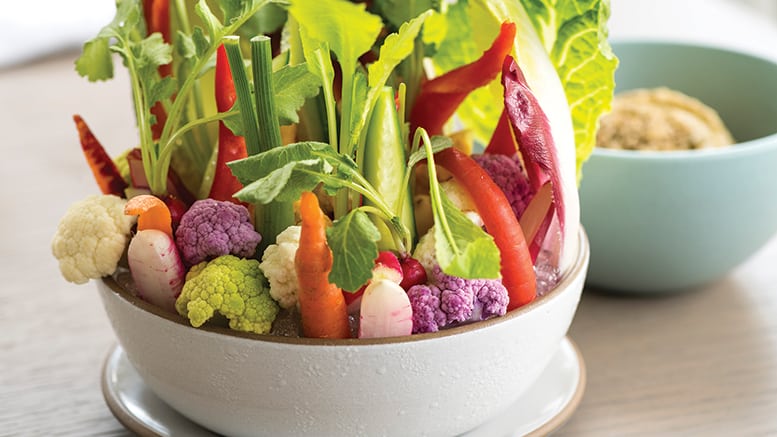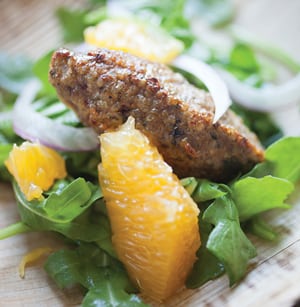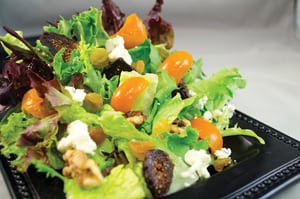Ready For Prime-Time Viewing
August 1, 2018 | 6 min to read
In today's Instagram culture, restaurant dishes must be visually striking, leading chefs to prioritize color in their presentations. According to experts like Brian Kaywork and Jesse Gideon, using vibrant fruits, vegetables, and herbs enhances both aesthetic appeal and flavor, captivating diners who "eat with their eyes first." Seasonal produce and innovative techniques can create stunning plates that amplify taste and memory, proving that presentation is now an essential aspect of the culinary experience.

Originally printed in the August 2018 issue of Produce Business.
Diners’ obsession with Instagram means restaurant dishes must be prepared for their close-up at all times. Fruits and vegetables are an ideal way to add color, visual appeal and texture to the plate.
 Flavor always comes first when creating a dish, but presentation is a major consideration as well. One of the best ways to make a meal look as good as it tastes is to add color. “When color is used in a correct way it brings visual appeal,” says Brian Kaywork, lecturing instructor for American Bounty Restaurant, a farm-to-table restaurant located on the Hudson Valley campus of The Culinary Institute of America, which is based in Hyde Park, NY. “However, it can be more than that. It brings vitality and life to a dish.”
Flavor always comes first when creating a dish, but presentation is a major consideration as well. One of the best ways to make a meal look as good as it tastes is to add color. “When color is used in a correct way it brings visual appeal,” says Brian Kaywork, lecturing instructor for American Bounty Restaurant, a farm-to-table restaurant located on the Hudson Valley campus of The Culinary Institute of America, which is based in Hyde Park, NY. “However, it can be more than that. It brings vitality and life to a dish.”
Color can come from grilling meats or concentrating sauces, but if the goal is to add an array of bright hues (not to mention great flavor), produce is a key ingredient. “Produce is generally going to be natural colors,” says Jesse Gideon, president and chief culinary officer of Fresh To Order, a “fine-fast” restaurant chain with 10 locations in Georgia, South Carolina and Indiana. The company’s headquarters is in Alpharetta, GA. “They’re colors that people grew up seeing all around them. They see them in grass, in trees, in the changing of the leaves, at the grocery store.” Those colors hint at the nutritional value of the food, which makes our brains light up and encourage us to dive in. That’s a big reason people say we eat with our eyes first.”
There are some good business reasons for adding color to the plate as well. Eating at a restaurant is about more than sustenance. It’s about having an experience, and how food looks is part of that experience. “You really have one shot at making a good first impression,” says Brian Stapleton, vice president of food and beverage for Aramark Parks and Destinations, a branch of the multinational company engaged in foodservice, facilities management and uniform provision that has its headquarters in Philadelphia. “If the plate comes and it’s not pleasing to the eye, it’s already somewhat suspect in your mind’s eye. That first impression can be enhanced through your presentation.”
In addition, the rise of social media has changed the way we eat out. “We’re living in an Instagram world,” says Katie Haggart, trendologist with af&co. a restaurant and hospitality consultant firm based in San Francisco. “The more photo-friendly the food is the better, and color absolutely helps food look more beautiful.”
Fruits, vegetables and herbs allows chefs to add interesting shapes and textures to a dish. As more unusual varieties of produce become widely available, it’s easier than ever to add color in unexpected ways. Haggart points to yellow, purple and green cauliflower as an example, or Mountain Rose apples, which have pink streaks through their pale flesh. These unexpected sources of color are likely to wow guests and keep them coming back for more.
Tastes of the rainbow
“Chefs have an arsenal of choices for incorporating color to a dish: purées, sauces, specific cut sizes or niche items,” says Kaywork. “Edible flowers and microgreens continue to be great options (with judgment) for plates. In our kitchen we have used vegetables in unique ways: carrot hummus (without beans), salt-baked squash carpaccio, fava bean puree, spring pea pasta sauce and yellow beet tartare.”
Stapleton has long been an advocate for using produce-infused purées and sauces to add color. “When I was making Cabernet-based sauces, I would add red beet to the sauce because it would give it this really incredible color profile when you put it on the plate. It was much richer because of the influence of the beet.” He used carrot, golden beet and sweet potatoes to deepen the color of sauces.
Using a monochrome color scheme also can add interest. Haggart points to the Tartine Bowl, a salad available at the Bay Area locations of the restaurant chain Sweetgreen. Fresh greens are topped with purple carrots and radishes, raw beets and basil. The dish was inspired by the book “Tartine All Day” by Liz Prueitt.
How to use produce to add color to a dish
Most chefs start thinking about the appearance of a dish near the end of the planning process. “Color is the last piece of the puzzle for me when I’m building a plate,” says Gideon. “I’m first thinking about, is it going to taste good and what is the flavor I’m trying to pass on to the guest. The next thing I’m thinking about is texture and mouthfeel. After that point is generally when I’m thinking about colors.
“A lot of times I’m not using color for the sake of adding something green or red, I’m adding color so you can see the center of the plate that much better,” he continues. “You don’t know how black something is until it’s with something white. I’m always thinking about, are there contrasting colors that let you appreciate that red strawberry or yellow corn or the color of the butternut squash,” adds Gideon.
In the final stages of developing a dish, Kaywork sometimes will consider whether he can substitute the standard vegetables in a dish with something more exciting. “An example would be a roasted carrot appetizer with Moroccan spices and labneh,” he says. “Would the dish have a more profound impact with multicolored carrots and the addition of micro-cilantro salad? Perhaps.”
 It’s important to think about seasonality when putting produce on a plate, says Stapleton. “In the summer season you have bright tomatoes, you have great fresh Mozzarella and basil.” People associate those bright colors with the time of year, so it makes sense to use them. The same is true for the deeper hues of fall produce, the browns and whites of winter produce, and the Chartreuse and green shades of spring foods.
It’s important to think about seasonality when putting produce on a plate, says Stapleton. “In the summer season you have bright tomatoes, you have great fresh Mozzarella and basil.” People associate those bright colors with the time of year, so it makes sense to use them. The same is true for the deeper hues of fall produce, the browns and whites of winter produce, and the Chartreuse and green shades of spring foods.
Cooks are also likely to use different cooking methods at different times of year. For example, summer calls for grilling and sautéing meats, while winter often means braising or roasting them. That can change the color profile of the meat. Different types of produce will be necessary to accentuate those shades.
Kaywork says it’s important to exercise good judgment when it comes to adding color. “Like Miles Davis said, ‘It’s not the notes you play, it’s the notes that you don’t.’ Not every dish needs a rainbow on the plate, but a well-chosen decision will accent and complement the rest of the dish. Also, be sure to not overreach with your produce selection. Ask yourself, does your selection make sense for the dish?”
Chefs must also think about cooking techniques when using fruits and vegetables to add color. “If you understand produce and how to work with it, you can make the colors brighter and stronger, or you can make them more muted,” says Gideon. “Steaming brings the chlorophyll of something like broccoli to the surface, so it makes it brighter. Then you have the question of, do I put it in ice water to stop it there, or do I let it cook to mute the color? There are lots of options. You can make it olive drab or almost neon green.”
Herbs for more impact
Herbs can also be used to add interest to a dish – although not in the same way they were in the past. “There was a period of time in the 80s and early 90s when you would put food on a plate, and if you didn’t hit a home run you’d finish it with chopped herbs of some sort,” says Aramark’s Stapleton. “That methodology has gone away. If you’re thinking about putting something on the plate that’s not adding value to the total experience, you shouldn’t put it on.”
“I use a lot of herbs because they’re beautiful, especially if they have flowers on them,” says Gideon. “We don’t really mince or grind them. We have a very rough cut, because it gives them that spark and zing that resets your palate. Texturally they’re very interesting. I would rather look at fresh mint than fresh basil. It has bumps and ridges that capture light in interesting ways.”
“On most occasions, herbs are accents to the dish that brighten and enhance,” says Kaywork. “On certain occasions, the herbs are the stars of the dish. Think pasta a la Genovese or chimichurri. Often the herbs are green and uniform in color. However, there are choices that can offer alternative colors, such as chive flowers or purple basil.”
Color, color everywhere
“Color is becoming more important across the board,” says Haggart with af&co. That being said, restaurants in different categories often end up approaching their use of color slightly differently. “Fine-dining restaurants have always had a bigger focus on crafting beautiful dishes that are pleasing to the eye, but fast-casual restaurants are also having to step up their game. They’re just as often – if not more – photographed than fine-dining restaurants because people can afford to eat there more often.”
Fine-dining restaurants often can use more creative methods of adding color because they can charge more for their food. People also are willing to wait longer for their food to be delivered, Stapleton points out, which means chefs can spend more time perfecting the plate.
Even though purple endive and microgreens may be too expensive for some restaurants, “there are certainly ways to get creative and incorporate color in an affordable way,” says Haggart. “Shaving rainbow carrots into a salad is more cost-effective than edible flowers.”
12 of 23 article in Produce Business August 2018

